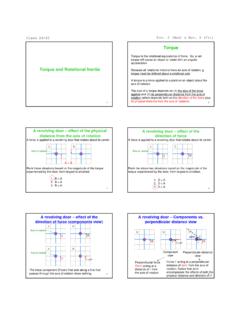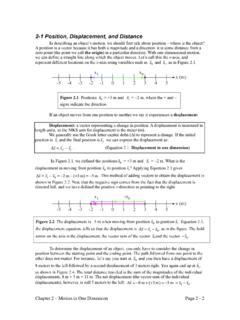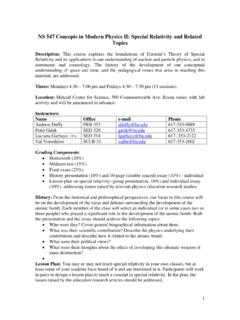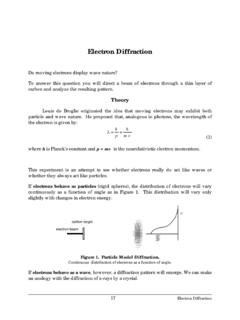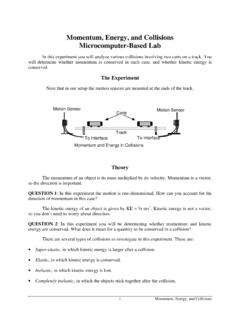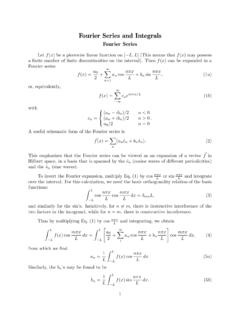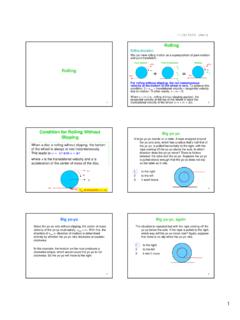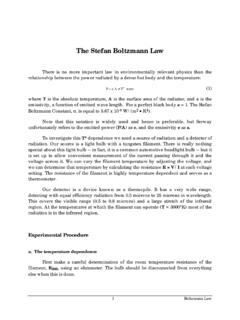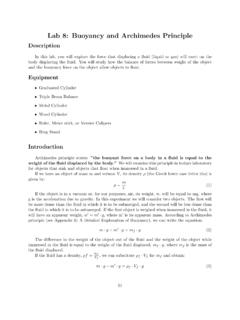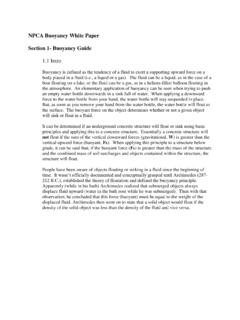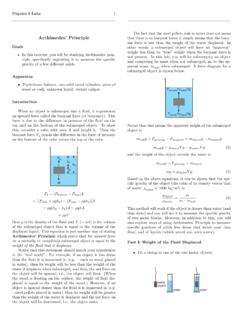Transcription of Chapter 9 – Fluids - Boston University Physics
1 Flowing Fluids , such as the water flowing in the photograph at Coors Falls in Colorado, can make interesting patterns. In this Chapter , we will investigate the basic Physics behind such flow. Photo credit: Digital is interesting to think about how much Physics is involved in the situation shown in the photograph. First of all, there is the influence of gravity, which makes the water flow down. Second, you can see the parabolic trajectories followed by the water as it is in free-fall at a number of different locations in the photograph. Third, there is the somewhat ghostly appearance of the water. This is caused by the photographer keeping the camera shutter open for an extended period as the picture was taken, with the motion of the water during this period causing a 9 FluidsCHAPTER CONTENTS 9-1 The Buoyant Force 9-2 Using Force Methods with Fluids 9-3 archimedes Principle 9-4 Solving buoyancy Problems 9-5 An Example buoyancy Problem 9-6 Pressure 9-7 Atmospheric Pressure 9-8 fluid Dynamics 9-9 Examples Involving Bernoulli s Equation In this Chapter on Fluids , we will introduce some new concepts, but the main focus will be on how to incorporate Fluids into the framework of forces and energy that we have examined in the earlier chapters.
2 Although we will address basic issues related to flowing Fluids , in the first half of this Chapter our focus will be on static Fluids . What determines whether something floats or sinks in a fluid ? How can an object sink in one liquid, and yet float in a different liquid? How can a huge ocean liner float, when its mass is so huge, and being made from raw materials that would sink in water? Our study of Fluids begins with us addressing questions such as 9 Fluids Page 9 - 19-1 The Buoyant ForceWe should begin by defining what a fluid is. Many people think of a fluid as a liquid, but a fluid is anything that can flow. By this definition, a fluid can be a liquid or a gas. Flowing Fluids can be rather complicated, so let s start with static Fluids Fluids that are at s consider some experiments involving various blocks that float in a container of water.
3 The blocks are represented in Figure , which shows how the masses of the blocks compare, and also shows the free-body diagrams of the blocks as they sit in equilibrium on a table. Starting from the left, the first, second, and fourth blocks are all made from the same material. The other two blocks are both made from different first goal is to look at the similarities between the normal force (a force arising from contact between solid objects) and the force arising from the interaction between an object and a fluid that the object is completely or partly submerged in. Figure illustrates how the blocks float when they are placed in the container of water. We have taken some liberties here, because in reality some of the blocks would tilt 45 and float as shown in Figure Neglecting this rotation simplifies the analysis without affecting the Free-body diagrams for floating objectsSketch the free-body diagram of the blocks in Figure as they float in the container of water.
4 Note that each block is in equilibrium what does that imply about the net force acting on each block? Because each block is in equilibrium, the net force acting on each block must be zero. What forces act on each block? As usual there is a downward force of gravity. Because each block is in equilibrium, however, the net force acting on each block is zero. For now, let s keep things simple and show, on each block, one upward force that balances the force of gravity. The free-body diagrams are shown in Figure Note that there is no normal force, because the blocks are not in contact with a solid object. Instead, they are supported by the fluid . We call the upward force applied by a fluid to an object in that fluid the buoyant force, which we symbolize as . Because the objects are only in contact with the fluid , the fluid must be applying the upward buoyant force to each block.
5 Compare the free-body diagrams in Figure , when the blocks are in equilibrium on the table, with the free-body diagrams in Figure , when the blocka Chapter 9 Fluids Page 9 - 2 Figure : A diagram of the blocks we will place in a beaker of water, and the free-body diagram for each block as it sits on a : A diagram of the blocks floating in the beaker of : We will ignore the fact that blocks that are submerged more than 50% tend to float rotated by 45 from the way they are drawn in Figure Neglecting this fact will simplify the analysis without affecting the in equilibrium while floating in the fluid . For a floating object, at least, there are a lot of similarities between the buoyant force exerted by a fluid and the normal force exerted by a solid Figures and closely. Even though the two blocks of mass 2m are immersed to different levels in the fluid , they displace the same volume of fluid , so they experience equal buoyant forces.
6 The 3m blocks displace 50% more volume than do the blocks of mass 2m, and they experience a buoyant force that is 50% larger. The block of mass m, on the other hand, displaces half the volume of fluid that the blocks of mass 2m do, and experiences a buoyant force that is half as large. We can conclude that the buoyant force exerted on an object by a fluid is proportional to Vdisp, the volume of fluid displaced by that object. We can express this as an equation (where means is proportional to ),. (Eq. : Buoyant force is proportional to volume of fluid displaced)Key idea about the buoyant force: An object in a fluid experiences a net upward force we call the buoyant force, . The magnitude of the buoyant force is proportional to the volume of fluid displaced by the object. Related End-of- Chapter Exercise: conclusion above is supported by the fact that if we push a block farther down into the water and let go, the block bobs up.
7 The buoyant force increases when we push the block down because the volume of fluid displaced increases, so, when we let go, the block experiences a net upward force. Conversely, when a block is raised, it displaces less fluid , reducing the buoyant force and giving rise to a net downward force when we let go. Figure shows these situations and the corresponding free-body Question : Two objects float in equilibrium in the same fluid . Object A displaces more fluid than object B. Which object has a larger mass? Chapter 9 Fluids Page 9 - 3 Figure : Free-body diagrams for the blocks floating in equilibrium in the beaker of water. FB represents the buoyant force, an upward force applied on each block by the : In this case, the blocks are not at equilibrium. The block on the left has been pushed down into the water and released.
8 Because it displaces more water than it does at equilibrium, the buoyant force applied to it by the water is larger than the force of gravity applied to it by the Earth and it experiences a net upward force. The reverse is true for the block on the right, which has been lifted up and released. Displacing less water causes the buoyant force to decrease, giving rise to a net downward : To be able to float, this large ship needs to displace a very large volume of fluid . This large volume of fluid is displaced by the part of the ship that is below the water surface, and which, therefore, is not visible to us in this photograph. Photo credit: Corbis to Essential Question : Object A. When an object floats in equilibrium, the buoyant force exactly balances the force of gravity. Object A displaces more fluid , so it experiences a larger buoyant force.
9 This must be because object A weighs more than object Using Force Methods with FluidsEXAMPLE A block on a stringA block of weight mg = 45 N has part of its volume submerged in a beaker of water. The block is partially supported by a string of fixed length that is tied to a support above the beaker. When 80% of the block s volume is submerged, the tension in the string is N.(a)What is the magnitude of the buoyant force acting on the block?(b)Water is steadily removed from the beaker, causing the block to become less submerged. The string breaks when its tension exceeds 35 N. What percent of the block s volume is submerged at the moment the string breaks?(c)After the string breaks, the block comes to a new equilibrium position in the beaker. At equilibrium, what percent of the block s volume is submerged?
10 SOLUTIONAs usual, we should begin with a diagram of the situation. A free-body diagram is also very helpful. These are shown in Figure (a) On the block s free-body diagram, we draw a downward force of gravity, applied by the Earth. We also draw an upward force of tension (applied by the string), and, because the block displaces some fluid , an upward buoyant force (applied by the fluid ). The block is in equilibrium, so there must be no net force acting on the up to be positive, applying Newton s Second Law gives:.Evaluating the left-hand side with the aid of the free-body diagram gives: .Solving for the buoyant force gives: .(b) As shown in Figure , removing water from the beaker causes the block to displace less fluid , so the magnitude of the buoyant force decreases. The magnitude of the tension increases to compensate for this.

